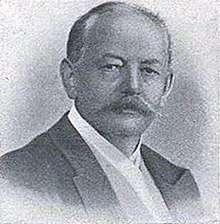Eichler system
A system of plant taxonomy, the Eichler system was the first phylogenetic (phyletic) or evolutionary system.[1][2] It was developed by August W. Eichler (1839–1887), initially in his Blüthendiagramme (1875–1878) and then in successive editions of his Syllabus (1876–1890).[3][4][5] After his death his colleague Adolf Engler (1844–1930) continued its development, and it became widely accepted.

The system was based on dividing the plant kingdom into those plants with concealed reproductive organs (non-floral), the (Cryptogamae, = hidden reproduction) and those with visible reproductive organs (floral), the (Phanerogamae, = visible reproduction).[6] Moreover, Eichler was the first taxonomist to separate the Phanerogamae into Angiosperms and Gymnosperms and the former into Monocotyledonae and Dicotyledonae.[7] His primary ranks were Divisions (Abtheilung), followed by orders (Reihe).
Blüthendiagramme (1875–1878)
Volume I (1875)
Contents pp. VI–VIII
Synopsis:
- Division I Gymnospermae p. 54
- Division II Monocotyledoneae p. 73
- Division III Dicotyledoneae p. 187 (part)
Volume II (1878)
Contents pp. V–VIII
Synopsis:
- Division III Dicotyledoneae p. 187 (continued)
Syllabus (Fourth edition 1886)
The system (here taken from the 4th edition of the Syllabus, 1886) divides plants into divisions, classes and groups. Groups were further divided into orders.
- Note: ranks translated into Latin

| German | Latin | English |
|---|---|---|
| Abteilung | divisio | Division |
| Unterabteilung | subdivisio | Subdivision |
| Klasse | classis | Class |
| Reihe | ordo | Order |
| Unterreihe | subordo | Suborder |
| Fam. | familia | Family |
| Unterfam. | subfamilia | Subfamily |
| Gruppe | tribus | Tribe |
| Gattung | genus | Genus |
| Art | species | Species |
Outline: p. 6.[8] Page numbers refer to text
- A. Cryptogamae
- division I. Thallophyta
- classis I. Algae
- group I. Cyanophyceae
- group II. Diatomeae
- group III. Chlorophyceae p. 8
- group IV. Phaeophyceae
- group V. Rhodophyceae
- classis II. Fungi
- group I. Schizomycetes
- group II. Eumycetes
- group III. Lichenes
- classis I. Algae
- division II. Bryophyta
- division III. Pteridophyta p. 21
- classis I. Equisetinae
- classis II. Lycopodinae
- classis III. Filicinae
- division I. Thallophyta
- B. Phanerogamae
- division I. Gymnospermae p. 33
- division II. Angiospermae p. 34
- classis I. Monocotyleae (7 orders) p. 34
- order I. Liliiflorae p. 34
- ordo II. Enantioblastae
- ordo III. Spadiciflorae
- ordo IV. Glumiflorae
- ordo V. Scitamineae
- ordo VI. Gynandreae
- ordo VII. Helobiae
- classis II. Dicotyleae p. 39
- subclassis I. Choripetalae
- subclassis II. Sympetalae p. 58
- classis I. Monocotyleae (7 orders) p. 34
Class Monocotyleae
- order I. Liliiflorae p. 34 (6 families)
- 1. Liliaceae (3 subfamilies)
- 2. Amaryllidaceae p. 35
- 3. Juncaceae p. 35
- 4. Iridaceae p. 35
- 5. Haemodoraceae p. 35
- 6. Dioscoreaceae p. 35
- 7. Bromeliaceae p. 35
- ordo II. Enantioblastae p. 35
- ordo III. Spadiciflorae p. 36
- ordo IV. Glumiflorae p. 36
- ordo V. Scitamineae p. 38
- ordo VI. Gynandreae p. 38
- ordo VII. Helobiae p. 38
- order I. Liliiflorae p. 34 (6 families)
See also
- Phylogenetic system
References
Bibliography
Works by Eichler
- Eichler, August W. (1875). Blüthendiagramme: construirt und erläutert. 2 vols [Floral diagrams]. Leipzig: W. Engelmann. Retrieved 17 May 2015.CS1 maint: ref=harv (link)
- Syllabus der Vorlesungen über Phanerogamenkunde Lipsius und Tischer, Kiel 1876.
- Subsequent editions published as Syllabus der Vorlesungen über specielle und medicinisch-pharmaceutische Botanik, 2nd ed. 1880, 3rd ed. 1883, 4th ed. 1886, 5th 1890
- Eichler, August W. (1880) [1876]. Syllabus der Vorlesungen über specielle und medicinisch-pharmaceutische Botanik (2nd ed.). Berlin: Borntraeger.CS1 maint: ref=harv (link)
- Eichler, August W. (1883) [1876]. Syllabus der Vorlesungen über specielle und medicinisch-pharmaceutische Botanik (3rd ed.). Berlin: Borntraeger.CS1 maint: ref=harv (link)
- Outline: p. 1 (Eichler 1883, p. 1)
- Eichler, August W. (1886) [1876]. Syllabus der Vorlesungen über specielle und medicinisch-pharmaceutische Botanik (4th ed.). Berlin: Borntraeger.CS1 maint: ref=harv (link)
- Eichler, August W. (1890) [1876]. Syllabus der Vorlesungen über specielle und medicinisch-pharmaceutische Botanik (5th ed.). Berlin: Borntraeger.CS1 maint: ref=harv (link)
- Subsequent editions published as Syllabus der Vorlesungen über specielle und medicinisch-pharmaceutische Botanik, 2nd ed. 1880, 3rd ed. 1883, 4th ed. 1886, 5th 1890
Other
- Oudemans, C.A.J.A. (1896). Rangschikking der Planten.CS1 maint: ref=harv (link) in Oudemans, C.A.J.A. & Hugo de Vries. Leerboek der plantenkunde, ten gebruike bij het hooger onderwijs.CS1 maint: ref=harv (link) volume 2(2).
- Engler, Adolf (1903) [1892]. Syllabus der Pflanzenfamilien : eine Übersicht über das gesamte Pflanzensystem mit Berücksichtigung der Medicinal- und Nutzpflanzen nebst einer Übersicht über die Florenreiche und Florengebiete der Erde zum Gebrauch bei Vorlesungen und Studien über specielle und medicinisch-pharmaceutische Botanik (3rd ed.). Berlin: Gebrüder Borntraeger Verlag. p. 233. Retrieved 31 January 2014.CS1 maint: ref=harv (link)
- Lawrence, G. H. M. (1951). Taxonomy of vascular plants.CS1 maint: ref=harv (link)
- Core, Earl Lemley (1955). Plant taxonomy. Prentice-Hall. Retrieved 19 May 2015.
- Goldberg, Aaron (1986). "Classification, Evolution and Phylogeny of the Families of Dicotyledons". Smithsonian Contributions to Botany. 58: 1–314.CS1 maint: ref=harv (link)
- Sharma, O. P. (2009). Plant Taxonomy (2nd ed.). Tata McGraw-Hill Education. ISBN 9781259081378. Retrieved 18 May 2015.CS1 maint: ref=harv (link)
- Stuessy, Tod F. (2009). Plant taxonomy: the systematic evaluation of comparative data (2nd ed.). New York: Columbia University Press. ISBN 0-231-51864-1. Retrieved 5 May 2015.CS1 maint: ref=harv (link)
Note: This is a selected list of the more influential systems. There are many other systems, for instance a review of earlier systems, published by Lindley in his 1853 edition, and Dahlgren (1982). Examples include the works of Scopoli, Ventenat, Batsch and Grisebach.